I put Emma's Hybrid Airgrid mattress to the test – if you want a mattress-in-a-box that has plenty of bounce, this is it
My Emma Hybrid Airgrid mattress review puts the brand's premium mattress through its paces
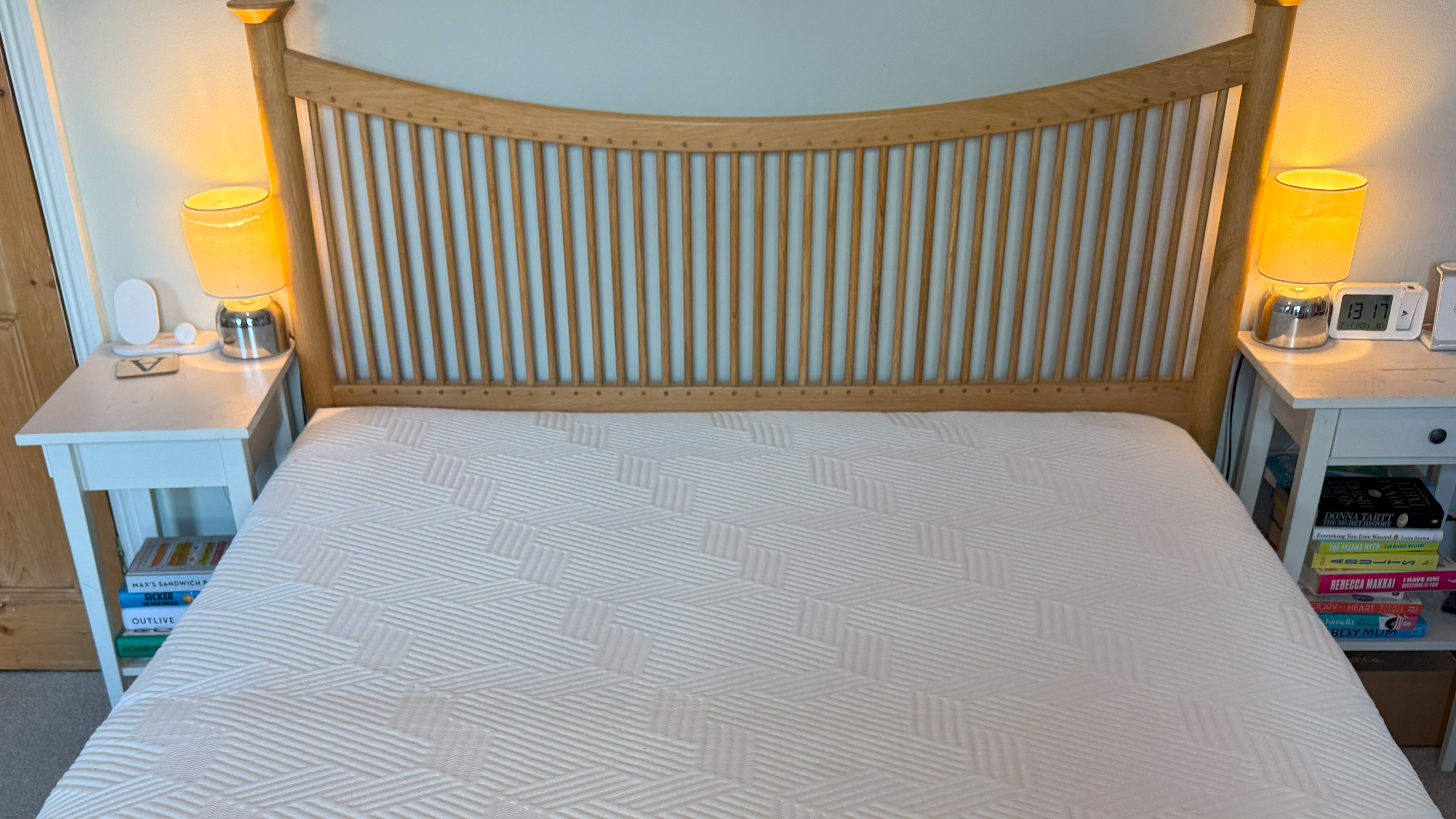
Emma's Hybrid Airgrid mattress offers plenty of bounce, but it may be a little *too* bouncy for some
-
+
Very responsive with a good bit of bounce
-
+
Cushioning and gently supportive, especially for side sleepers
-
+
Decent breathability and temperature regulation
-
-
Lacks motion isolation
-
-
Lacks edge support
-
-
May lack enough support for heavier-weight sleepers
-
-
Delivery to your room of choice is an extra charge
-
-
Limited efforts to address environmental impact
Why you can trust Ideal Home

The Emma Hybrid Airgrid Mattress was renamed by Emma at the beginning of 2025, so you might be more familiar with its previous name, the Emma Elite Mattress.
In this Emma Hybrid Airgrid Mattress review, I put the brand's premium model through its paces to see how it performs in comparison to the best mattresses on the market.
In a nutshell
I’ve tested almost 30 mattresses as a sleep-product tester, from hybrid mattresses to pocket sprung and memory foam mattresses. So I was keen to see how Emma’s latest iteration – the Emma Hybrid Airgrid Mattress – would fare against my stringent tests.
Overall, I found the Emma Hybrid Airgrid mattress to offer gentle support and good temperature regulation. The clever Airgrid layer makes this a much more responsive and 'bouncy' mattress than many other hybrid memory foam mattresses I've tested. Personally, I don't enjoy the feeling of sinking into and being 'cocooned' in a memory foam sleep surface, so I, for one, appreciated this.
However, I also found that extra springiness had a downside, and that was poor motion isolation. I share a bed with my husband, and I was very aware that I was being bounced around when he moved next to me on the mattress.
I was also disappointed by the edge support on the Emma Hybrid Airgrid mattress, especially considering its price point, which at £999 for a double, isn't cheap.
All in all, if you prefer a medium to soft mattress, I did find the Emma Hybrid Airgrid very comfortable. I think it's a particularly good choice for side sleepers who want a responsive mattress that's easy to turn over on and has both cushioning and some bounce. However, if you're easily disturbed by a fidgety partner, this mattress isn't for you.
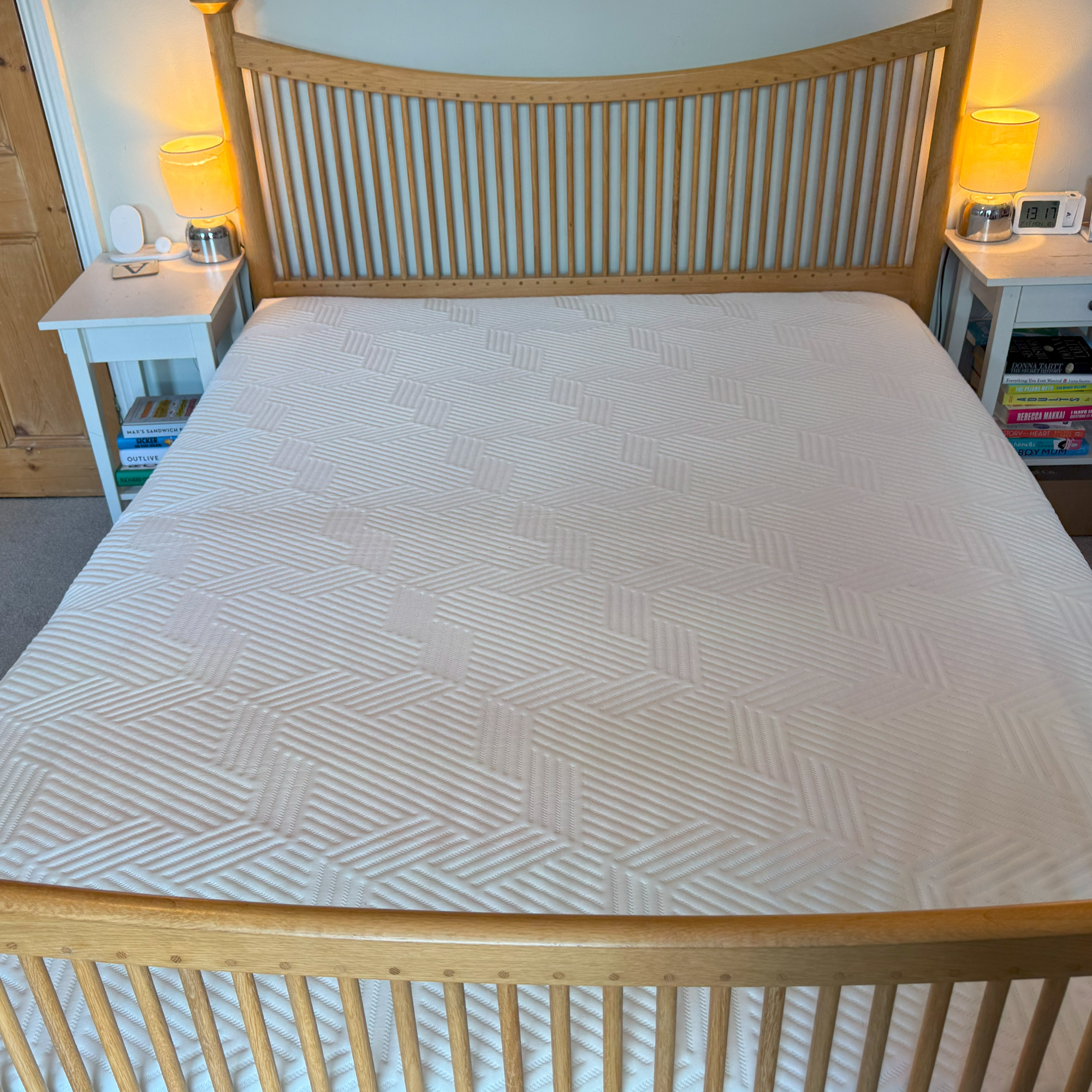
Emma Hybrid Airgrid Mattress review
Specifications
- RRP (double): £999
- Type: hybrid
- Construction materials: air grid, memory foam, pocket springs, support foam
- Sizes: single, double, king, super king
- Tensions available: medium-soft
- Height: 27cm
- Side handles: yes
- Flip or rotate: no
- Manufacturer sleep trial: 200 nights
1. Comfort
The Emma Hybrid Airgrid mattress is listed as a medium-soft tension. As someone whose preference is a medium-firm tension, I was initially a bit dubious about how comfortable I’d find the Airgrid mattress to sleep on.
Sign up to our newsletter for style inspiration, real homes, project and garden advice and shopping know-how
I’m a side sleeper. This means that some mattresses can cause my hip and shoulder to ache if they're too firm, or cause my lower back to ache if they're too soft. That's why the best mattress for a side sleeper is usually one that's medium-firm. A medium-firm tension allows the shoulder and hip to sink in to the mattress ever so slightly, but has enough support that the spine can rest in alignment without the waist dipping too low.
As the Emma Hybrid Airgrid mattress is a medium-soft mattress, I was concerned it wasn’t going to give me enough support for my midsection, and I’d wake up with an aching lower back, which is a pain I often encounter whenever I sleep somewhere other than my own bed.
However, when I lay on the mattress, I immediately felt like it was probably more medium than soft. My shoulders and hips dipped into the mattress slightly, but I could feel the mattress underneath my waist gently supporting me.
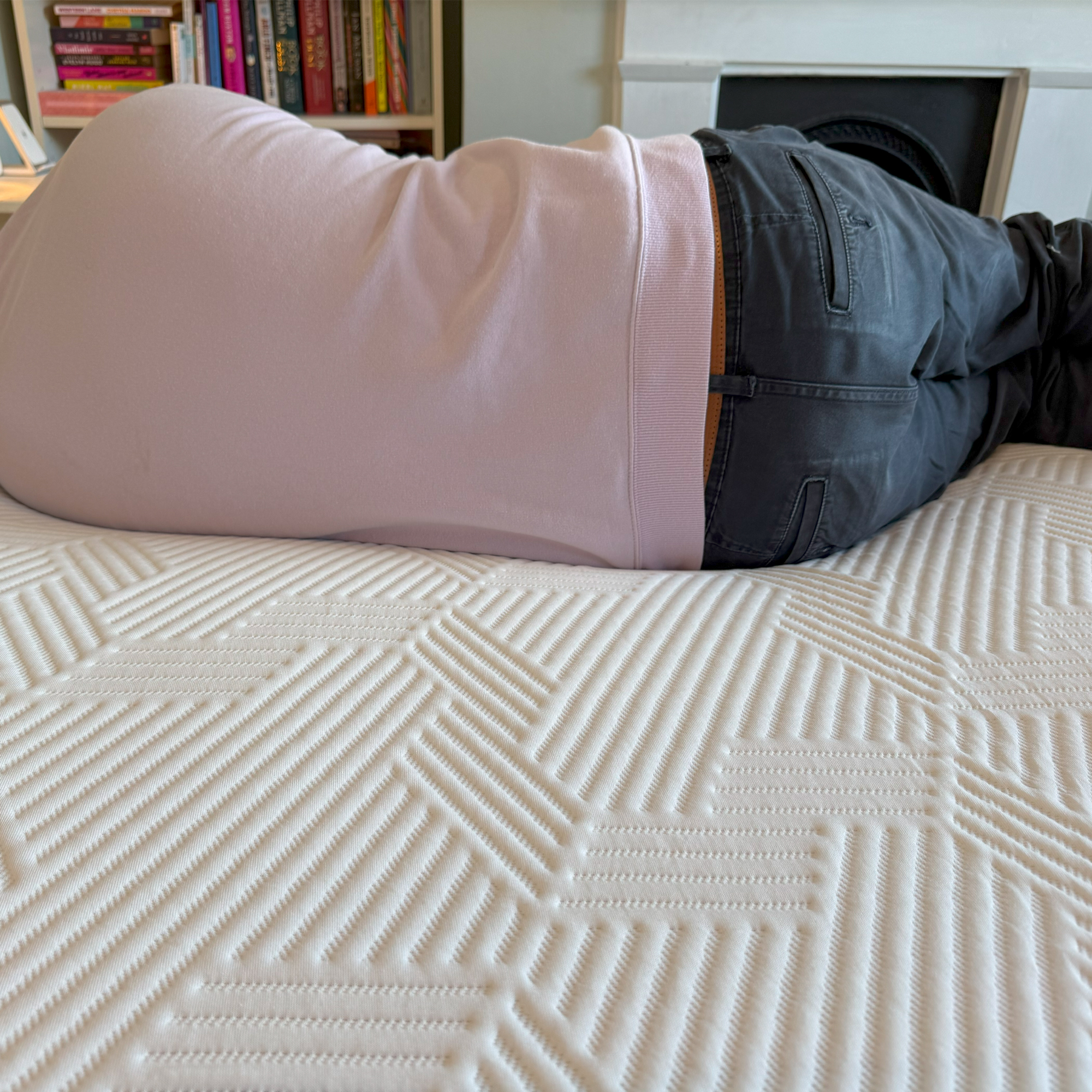
Next up, I tested it for back sleeping. My husband has unwittingly become a mattress co-tester – not a gig he ever signed up for, but here we are – and as luck would have it (for mattress-testing purposes at least), he’s a back sleeper. I also like to lie on my back when awake at night.
We both found that the Airgrid did well in rising to support our lower backs, but I did feel my hips sank down a little too far, and I felt a little overextended in this area.
Emma says their Airgrid layer and the zoned springs work together to provide 'exceptional support for your body's pressure points'. I agree that for a hybrid mattress, the Airgrid does offer really decent support – would I say it’s exceptional, particularly if compared to a traditional pocket spring mattress? Considering the above; probably not.
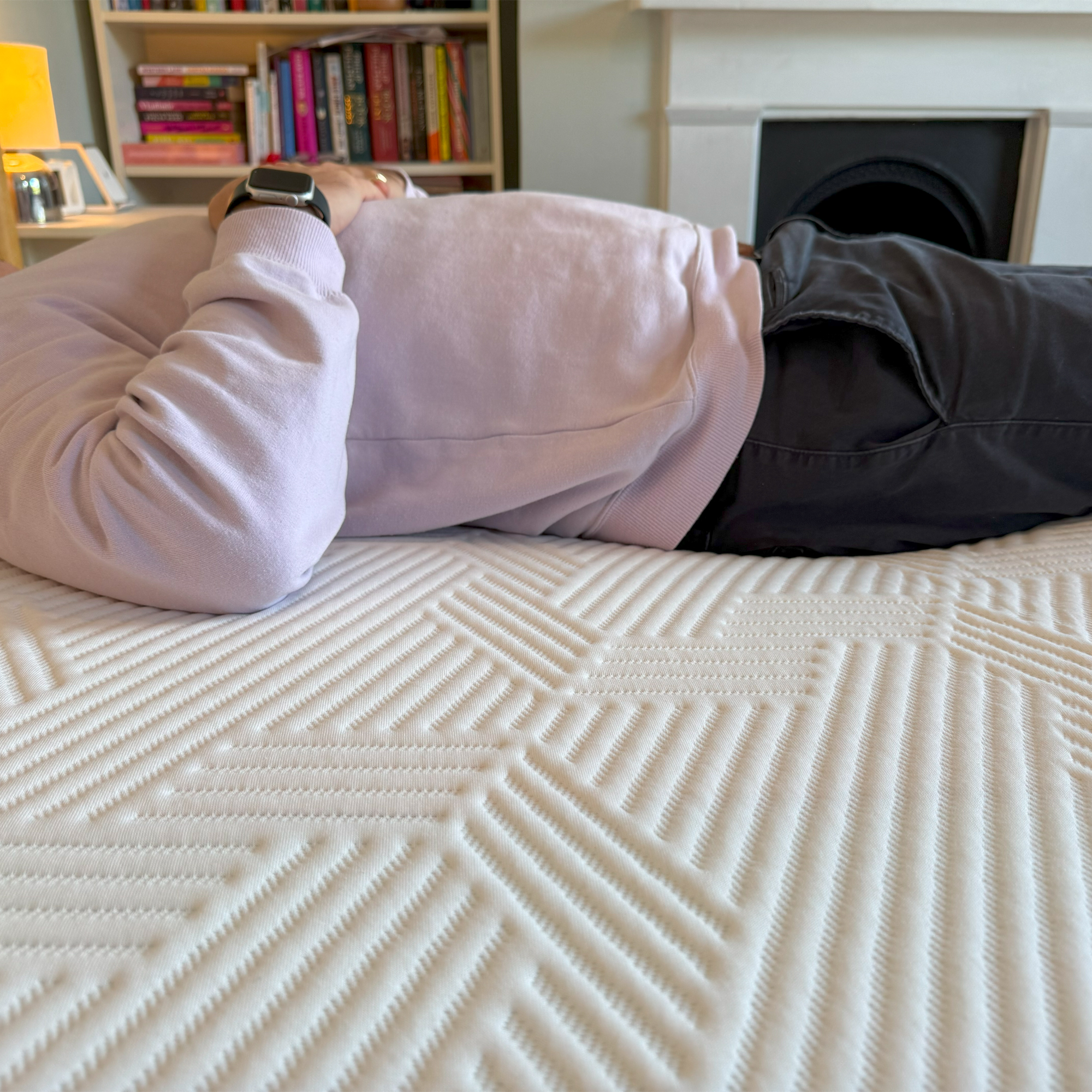
One thing I did really like about the Airgrid mattress was that it felt a lot more 'alive' and responsive than most mattresses in a box I've tested, which can often tend to feel a little dead and unresponsive due to their memory foam surface.
That's probably because Emma has added an extra layer to this mattress, and that's the 'Airgrid' layer. This is a slice of foam that looks like a grid, with squares cut out across the whole layer. The idea of this is to spread pressure from the body, so – in Emma’s words – 'you never feel heavy or like you’re sinking into the mattress'.
There's still a memory foam layer and pocket springs underneath, but I would definitely agree that the Airgrid layer kept me on the mattress surface rather than sinking *into* the mattress, which I much prefer. However, this responsiveness has some downsides, which I'll come to next.
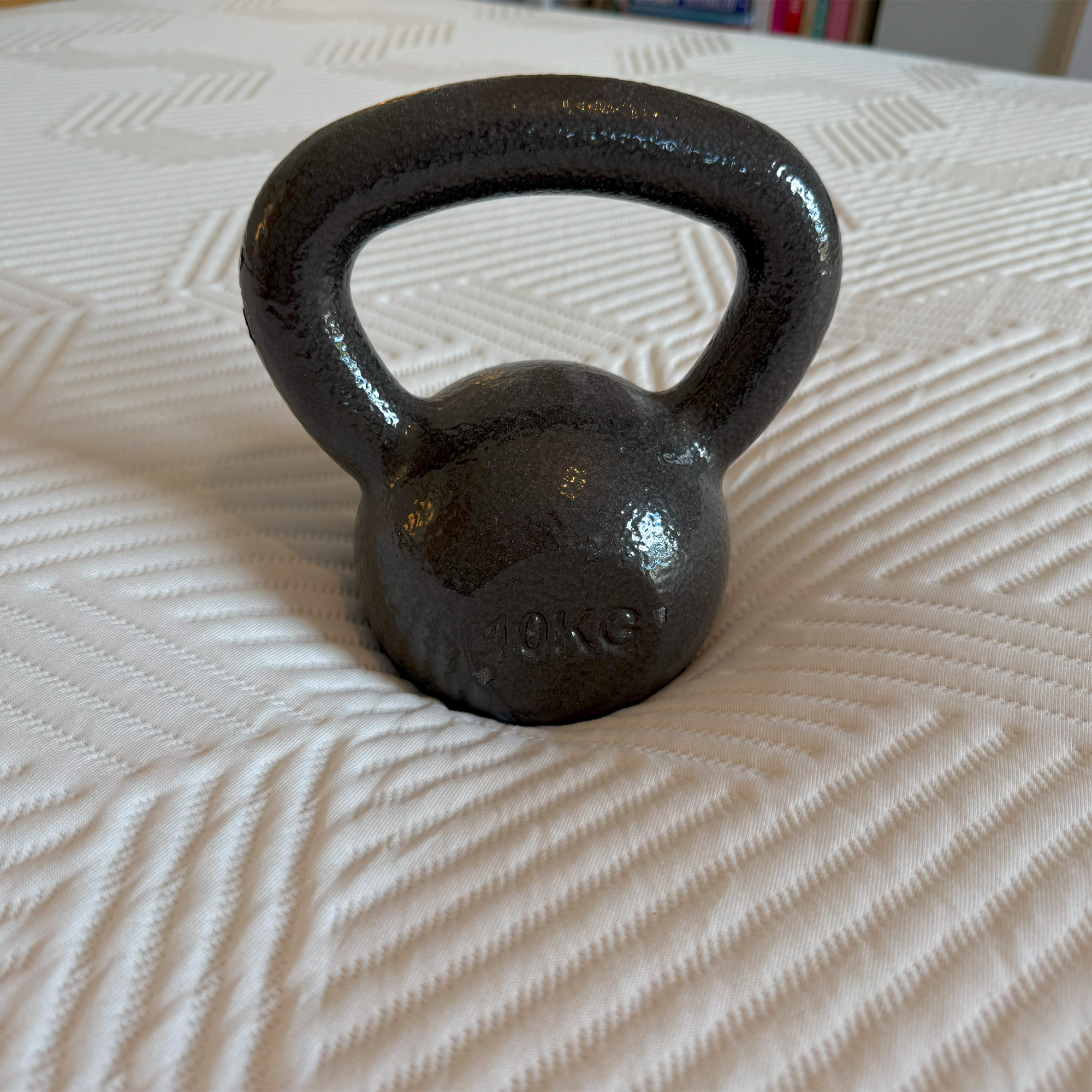
2. Motion isolation
Being able to sleep uninterrupted is never to be underrated. Feeling my husband move next to me is a sure-fire way to wake me up (and irritate me, if I’m honest), so I’m very fussy, and a mattress with good motion isolation is very important to us both.
I also have three kids who love to come in at 6.50 am on the dot and snuggle into bed with us. My ideal would be to not be able to feel them wiggling around next to me so I can squeeze in just 10 more minutes of snooze time.
So how did the Emma Hybrid Airgrid stand up to these tests? Not so great. Both my husband and I found that the mattress's movement isolation was poor. When I rolled over at night, it felt a bit like being on a bouncy castle!
I could also feel my husband moving about when he couldn’t sleep, and if he got out of bed in the night, I almost felt like I was going to bounce off the bed.
Luckily, my husband is someone who doesn’t move much in his sleep – a real bonus for the health of our marriage, whilst we tested the Emma Hybrid Airgrid mattress. But if you're part of a couple where one of you is prone to tossing and turning, whilst the other is a light sleeper, I would say this mattress isn't the one for you.
Poor | Okay | Good | Great | Excellent |
|---|---|---|---|---|
X | Row 0 - Cell 1 | Row 0 - Cell 2 | Row 0 - Cell 3 | Row 0 - Cell 4 |
3. Responsiveness
I really rate the responsiveness of this mattress in comparison to other memory foam hybrid mattresses I’ve tested.
I found the mattress didn’t mould around my body and make me feel smothered – a real bonus for me, as that sensation gives me 'the ick'. As someone who likes to freely move and stretch while I sleep and laze around, I much prefer a mattress that doesn’t make me feel like I have to put real effort into shifting about or changing position.
However, as I’ve previously mentioned, the mattress is *so* responsive it sometimes felt overly bouncy. My husband remarked that it was 'almost too bouncy' for his liking, and we found that we noticed when the other person changed position or rolled over and got in and out of bed far more on this mattress than our usual sleep surface.
Emma claims that 'as you shift in your sleep, the AirGrid layer rebounds in no time allowing you to toss and turn without even realizing it', which is true, but if you sleep with another person, I would say that you *will* notice when they toss and turn, because they're likely to make your side of the mattress bounce too.
Emma promises the Airgrid layer will offer 'weightless comfort', but I had real concerns about becoming airborne if anyone jumped onto the bed next to me!
4. Temperature regulation
I’d say I’m a hot sleeper who likes to be cosy. My husband is a hot sleeper who likes to be cold to sleep, so a mattress with good temperature regulation and breathability is important to us both.
Emma claims that the Hybrid Airgrid is its most breathable mattress ever. The brand says that the 'large air channels maximise airflow and keep the mattress from retaining heat, allowing it to maintain the ideal temperature all night long.'
I've previously tested the (now discontinued) Emma Original mattress and Emma Premium mattresses, and found I slept very warm on them both. I would find myself kicking off the covers even in December, so I was interested to see how the 'most breathable Emma mattress' would live up to its claims.
All in all, I would say I didn’t overheat on the Airgrid, even on the nights I was feeling very hot thanks to hormones. So here I find Emma’s claims valid – the Airgrid is definitely a more breathable product compared to the brand's previous models.
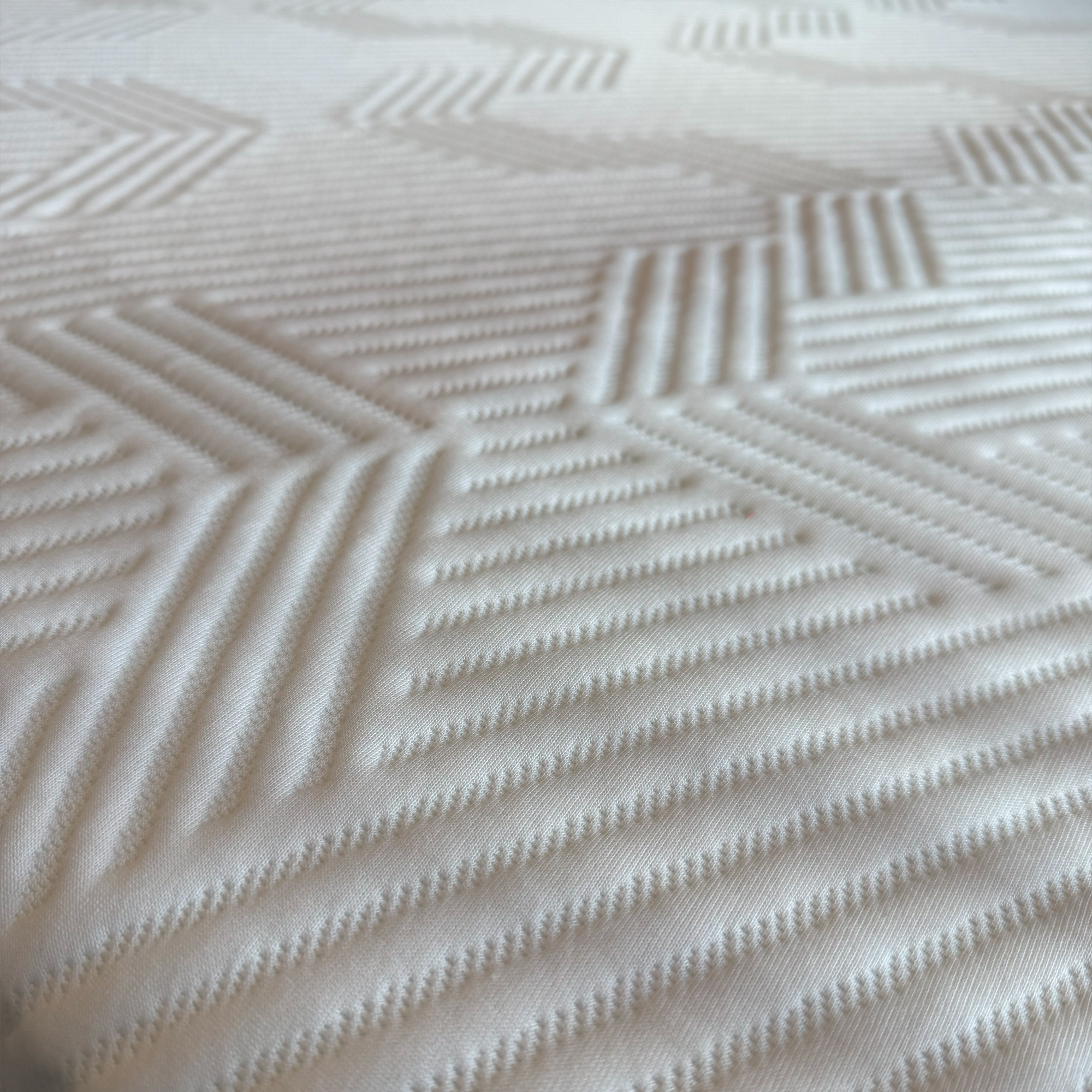
However, I usually sleep on the Hypnos Wool Origins 6 Mattress, and I definitely find its mixture of wool combined with pocket springs to offer better breathability and temperature regulation than the Emma Airgrid's synthetic fill.
So yes, for a synthetic mattress which employs memory foam, this mattress doesn't cause the same overheating many can, but compared to a wool-filled mattress, I can't say it's the *most* breathable sleep surface I've slept on. Overall, I'd say its breathability and temperature regulation is 'good', but not quite as good as the natural-fill mattresses I've tested.
Poor | Okay | Good | Great | Excellent |
|---|---|---|---|---|
| Row 0 - Cell 0 | Row 0 - Cell 1 | X | Row 0 - Cell 3 | Row 0 - Cell 4 |
5. Edge support
If you’re new to the world of edge support, it essentially means how well reinforced the sides of the mattress are. This is incredibly important, yet a factor that’s often overlooked when we shop.
Good edge support will ensure the entire mattress surface is supportive and gives you the maximum possible area to lie on. If you're a couple sharing a double mattress, this is especially important as you'll likely want to use every inch of space. Similarly, if, like me, you're a parent who often has extra little people climbing into bed. It's not uncommon for there to be five humans on my mattress if my three kids decide to join us.
Poor edge support means that when you roll close to the mattress edge, it may dip, and you can feel like you're about to roll out, which can wake you from an otherwise good night's sleep. Good edge support can also extend the lifespan of your mattress, stopping it from sagging over time.
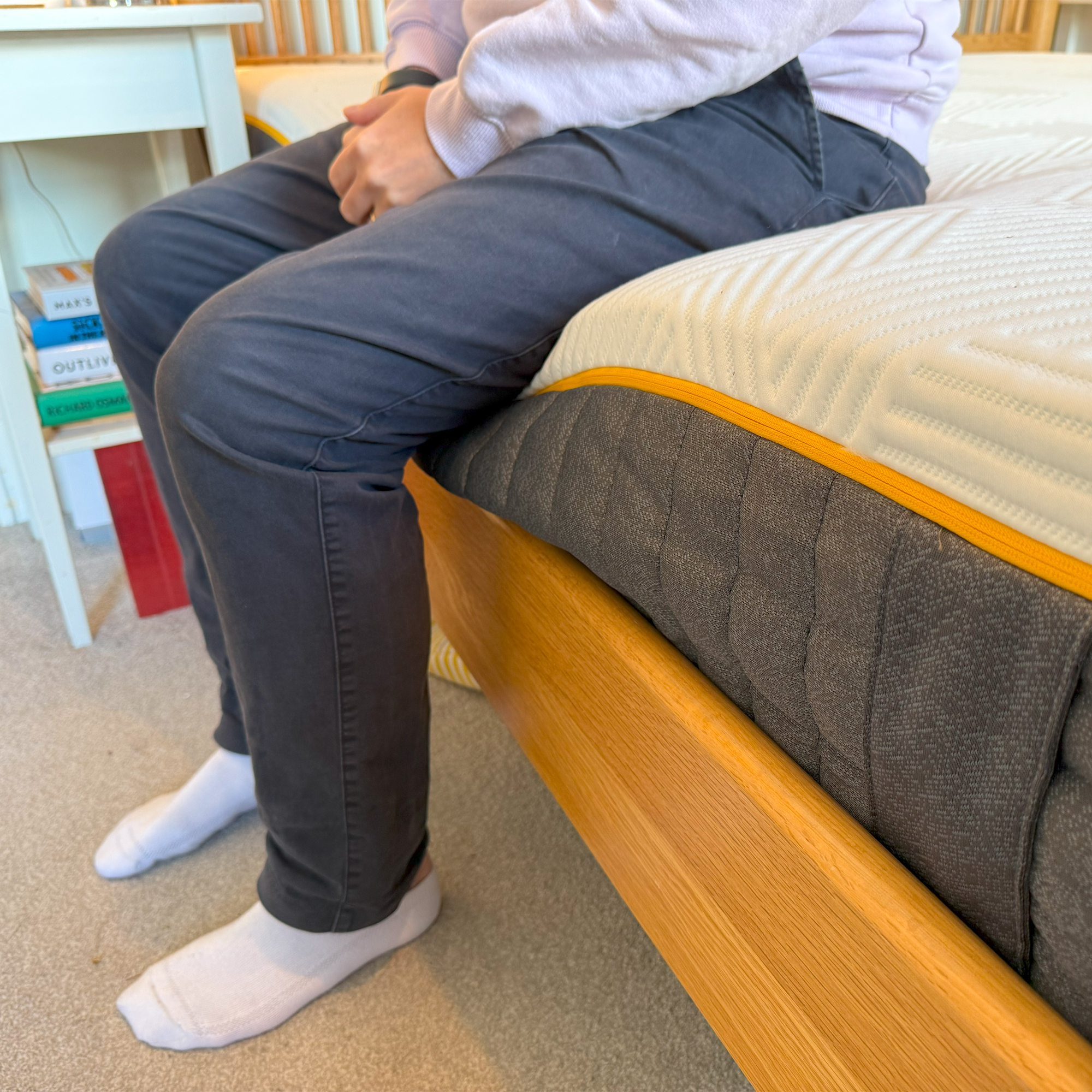
Some mattresses have firmer foam around the edges or higher-tension springs to provide extra edge support, and most manufacturers will shout about the methods they've taken to reinforce their mattresses' edges. However, I tried valiantly to find any information about reinforced edge support on the Airgrid mattress, and came up empty-handed.
Perhaps unsurprisingly, then, this was the main area I felt the Hybrid Airgrid was lacking. When lying right at the edge of the mattress, I initially thought the edge support was pretty good. I didn’t have to cling on, and I couldn’t feel it dip into the side of the bed.
However, I found the mattress sagged quite dramatically when I sat on the edge. It couldn’t stand up to this kind of focused pressure, and that made me wonder how the edges would hold up over time as the fillings naturally become more compressed.
It also wasn't ideal for sitting on the edge of the bed and putting on socks in the morning. It felt like an effort to stand from a sitting position, which may also be something anyone with limited mobility will struggle with. Overall, I gave its edge support a 2 out 5. Not terrible, but I'd definitely like it to be better, especially for a mattress of this price.
Poor | Okay | Good | Great | Excellent |
|---|---|---|---|---|
| Row 0 - Cell 0 | X | Row 0 - Cell 2 | Row 0 - Cell 3 | Row 0 - Cell 4 |
6. Sleep trial
Emma offers a 200-night sleep trial, which means you can buy the mattress, sleep on it at home for 200 nights, and return it if you find it doesn't suit you during this test period.
This is useful because it can take a while for our body to adjust to a new mattress, and, because Emma is an online retailer, it's very difficult to try an Emma mattress before you buy.
Make sure to check the terms and conditions on any sleep trial before you make a purchase, though; they vary from brand to brand, and there may be things you need to do to be compliant, such as purchasing one of the brand's own mattress protectors alongside the mattress.
7. Ease of care
To start with Emma recommends rotating your mattress monthly for the first six months to prevent body impressions. After the initial period you should then rotate it every three months.
The brand states that you should never flip your Airgrid mattress as the layers are stacked in a specific order that only 'work' one way.
The cover is removable and you can wash it if you want. This is no mean feat though. The mattress isn’t the heaviest mattress out there, so turning it could be done by one person with average strength, however, removing a mattress cover is another matter entirely. Personally, I would opt for one of the best mattress protectors instead.
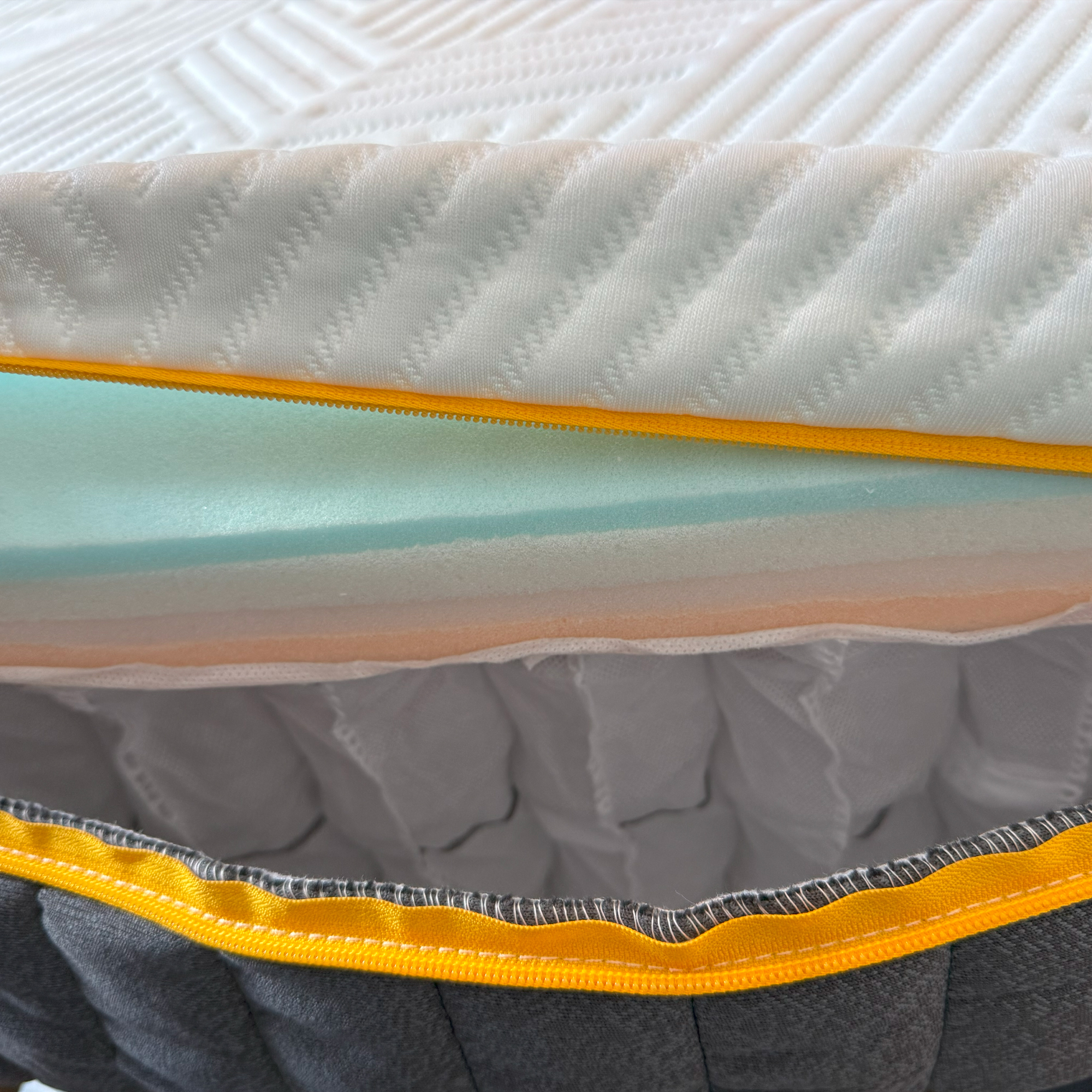
8. Delivery
When my Emma Hybrid Airgird order was placed, I received an email with my tracking information. I then received a text message from the courier (UPS in my case) the day before delivery, letting me know the mattress was due for delivery the next day.
However, unlike with most mattresses I've received for testing recently, I wasn’t given a specific delivery window. Instead, the mattress could have turned up at any point throughout the day. As I work from home, this didn't affect my day too much, but if you don’t work from home or you need to go out, this delivery process isn't very convenient. Most brands now offer a two-hour delivery window, which I much prefer.
My second bugbear was that the mattress was only delivered to my doorstep, and from there I had to shift it into the house myself. I tested the king-size version of this mattress, and although it comes rolled in a fairly compact box, it's still very heavy. It was a two-person job to get it up a flight of stairs, and this won't be heavy-lifting that everyone can do.
However, Emma does now offer delivery to your room of choice as a paid extra. Opt for Premium Delivery, which costs £35, and your mattress will be carried into your home by the two-person delivery team. This also means you're given a 3-hour delivery window on delivery day and a selection of possible delivery dates to choose from.

9. Value for money
I tested a king-size in the Emma Hybrid Airgid mattress, which costs, at the time of writing, £1,279. A double mattress costs £999, which I think is a pretty hefty price tag.
Indeed, this is Emma’s most expensive mattress, and had it passed my tests with flying colours, I might be willing to pay a premium for it. However, overall, I was left disappointed by the Airgrid's lack of motion isolation and its poor edge support.
For comparison, Simba's Hybrid Pro mattress costs £1,199 for a double. It's a slightly more expensive price tag, and a slightly firmer-feeling mattress, but I do feel it's a mattress-in-a-box that nails a lot of the areas that let Emma's Airgrid down.
No, Simba's mattresses don't have the bounce of the Airgrid, but, in my book at least, that turned out to be a good thing. I think the Airgrid has leaned a little too far in the other direction and become *too* bouncy.
10. Environmental impact
Emma doesn’t mention whether any of the synthetic materials used in the Airgrid come from recycled sources, which, I assume, means they do not.
The brand also doesn't offer to collect and responsibly dispose of any old mattresses like many of its competitors, such as Simba, do. And it’s not been made easy to recycle this mattress at the end of its lifespan. The layers are glued together inside, so it can't easily be dismantled to recycle each element.
Considering Emma is one of the biggest names in the mattress industry, and used mattresses going to landfill is such a big environmental problem, it's a shame the brand doesn't seem to be doing more to lead the way in combating this issue.
Instead, Emma's main nod to sustainability seems to be its Second Life scheme. This scheme takes previously owned products (likely those that have been returned during one of the brand's sleep trials), revamps them, and then resells them to a new owner at a lower price.
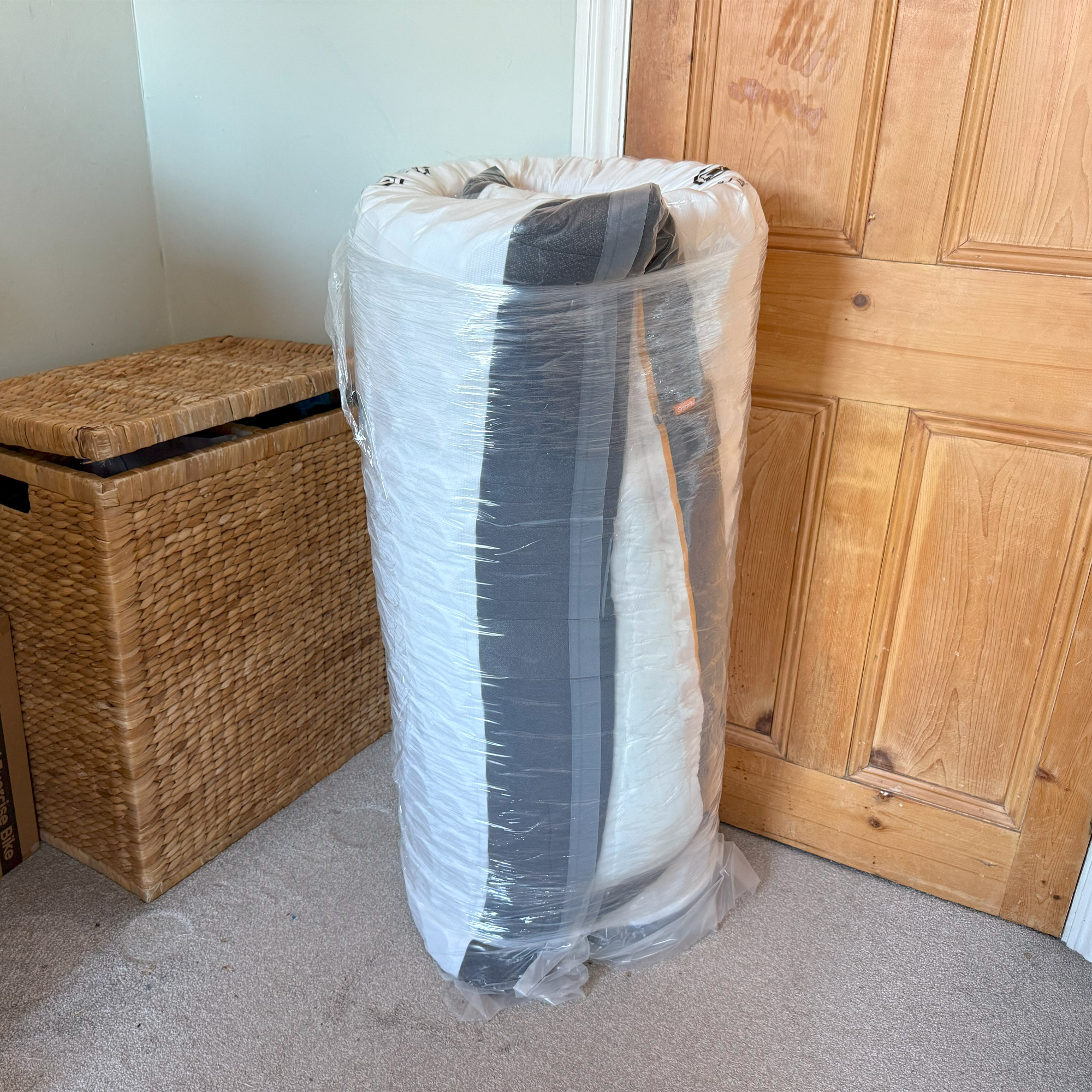
11. Third-party reviews
Third-party reviews of Emma’s Airgrid Hybrid mattress are limited, perhaps because this mattress is a fairly new addition to the range.
Some reviews I found said the mattress solved their aches and pains and had them sleeping better. However, one reviewer noted that the mattress isn’t firm enough for heavier builds or stomach sleepers, and something that comes up in many reviews is the poor edge support.
I'd agree with those comments. I think this mattress is best suited to lighterweight sleepers as it is fairly soft and doesn't offer the support heavier builds need. And I concur with the concerns around its lack of edge support.
How I tested

I’m Zoë, an experienced product tester who helps the Ideal Home team sleep-test mattresses, duvets, and toppers to find our top recommendations. For this review, I put the Emma Hybrid Airgrid Mattress through Ideal Home's testing process.
My sleep stats:
Sleep position: side
Tension preference: medium-firm
Sleep problems: hip pain
In putting the Emma Hybrid Airgrid Mattress through Ideal Home's mattress testing process, I assessed 11 factors that we deem vital to any mattress purchase.
I tested the mattress for comfort, motion isolation, responsiveness, temperature regulation, and edge support. This means that my husband and I slept on the mattress for a month before I wrote my review.
I also took into consideration ease of care, any sleep trials available, the delivery process, the mattress's value for money, and, where possible, researched the mattress's environmental impact and any third-party customer reviews – to see if they aligned or were at odds with my own experience – before writing my own review and giving this mattress a star rating.

Zoe is a freelance journalist and content strategist. Her career has traversed kids' publishing, women's lifestyle magazines, luxury property and content marketing. She's worked for the BBC, STYLIST, Marie Claire, heat, Wallpaper*, InStyle, The Sunday Times Style, Ocado, Christie's and more. She now regularly writes about interiors and sleep for a range of media – what she doesn't know about mattresses isn't worth knowing.
You must confirm your public display name before commenting
Please logout and then login again, you will then be prompted to enter your display name.